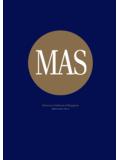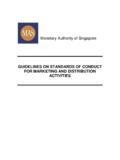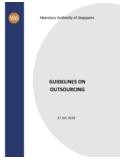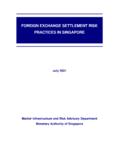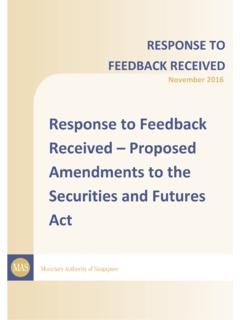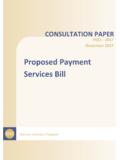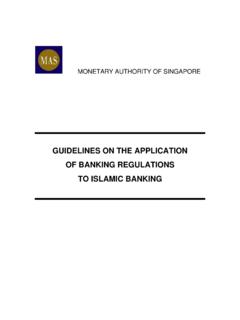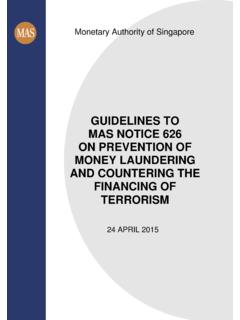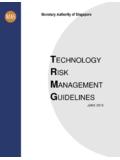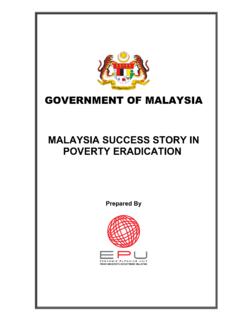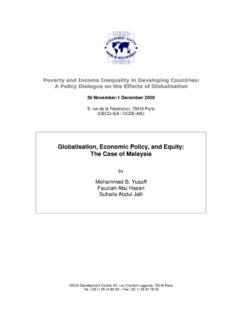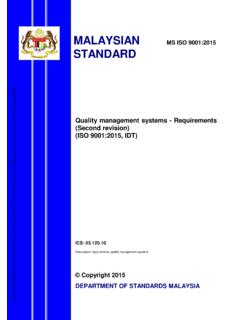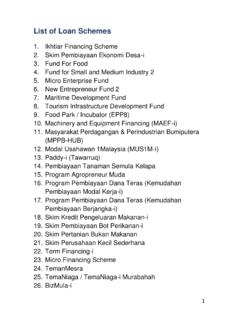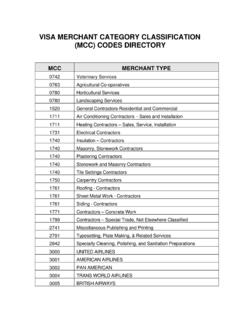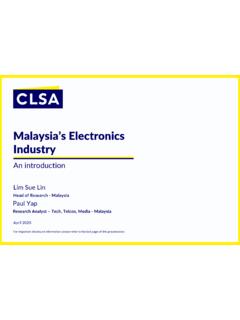Transcription of December 2021 - mas.gov.sg
1 I December 2021 ii Financial Stability Review | December 2021 Financial Stability Review December 2021 ISSN 1793-3463 Published in December 2021 Macroprudential Surveillance Department Economic Policy Group Monetary Authority of Singapore All rights reserved. No part of this publication may be reproduced, stored in a retrieval system or transmitted in any form or by any means, electronic, mechanised, photocopying, recording or otherwise, without the prior written permission of the copyright owner except in accordance with the provisions of the Copyright Act (Cap. 63). Applications for the copyright owner s written permission to reproduce any part of this publication should be addressed to: Macroprudential Surveillance Department Economic Policy Group Monetary Authority of Singapore 10 Shenton Way MAS Building Singapore 079117 iii Contents Preface vi Overview 1 1 Global Financial and Economic Environment Risks in the External Environment 4 2 Singapore Corporate Sector Risks in the Corporate Sector 18 Chart Panel 2A: Small and Medium-sized Enterprise Financing Conditions 29 3 Singapore Household Sector Risks in the Household Sector 30 4 Singapore Financial Sector Risks in the Banking Sector 42 Risks in the Non-banking Sector 47 Box A: Industry-wide Stress Test of D-SIBs 50 Box B.
2 Enhancements to Supervisory Stress Testing of Central Counterparties 56 Chart Panel 4A: Banking Sector: Credit Growth Trends 60 Chart Panel 4B: Banking Sector: Cross-border Lending Trends 61 Chart Panel 4C: Banking Sector: Asset Quality and Liquidity Indicators 62 Chart Panel 4D: Banking Sector: Local Banking Groups 63 Chart Panel 4E: Insurance Sector 64 Chart Panel 4F: Over-the-counter Derivatives 65 5 Special Features on Financial Stability Special Feature 1: Integrated Macro Policy Frameworks: An Assessment of the Ongoing Research 67 Special Feature 2: Climate Transition Risk Exposure of Singapore s Banking and Insurance Sectors 82 Special Feature 3: Enhancing Corporate Surveillance with Probability of Default Model 88 Special Feature 4: An Empirical Analysis of the Determinants of Domestic Interest Rates and Net Interest Margin 99 Data Annex Impact of Recent Regulatory Revisions on Banking Sector s Indicators 116 iv Financial Stability Review | December 2021 Statistical appendix may be accessed from: Disclaimer: MAS is not liable for any damage or loss of any kind, howsoever caused as a result (direct or indirect) of the use of any information or data contained in this publication, including but not limited to any damage or loss suffered as a result of reliance on the information or data contained in or available in this publication.
3 You are reminded to observe the terms of use of the MAS website, on which this publication is made available. v Definitions and Conventions As used in this report, the term country does not in all cases refer to a territorial entity that is a state as understood by international law and practice. As used here, the term also covers some territorial entities that are not states but for which statistical data are maintained on a separate and independent basis. In this report, the following groupings are used: ASEAN-4 comprises Indonesia, Malaysia, Philippines and Thailand. Emerging Asia comprises Asian economies such as China, Hong Kong, India, Indonesia, South Korea, Malaysia and Thailand. EMEA refers to Europe, Middle East and Africa.
4 Euro zone comprises Austria, Belgium, Cyprus, Estonia, Finland, France, Germany, Greece, Ireland, Italy, Latvia, Lithuania, Luxembourg, Malta, Netherlands, Portugal, Slovakia, Slovenia and Spain. LATAM refers to Latin America. Abbreviations used for financial data are as follows: Currencies: Australian Dollar (AUD), British Pound (GBP), Chinese Yuan (CNY), Euro (EUR), Hong Kong Dollar (HKD), Indian Rupee (INR), Japanese Yen (JPY), Korean Won (KRW), malaysian Ringgit (MYR), New Taiwan Dollar (TWD), New Zealand Dollar (NZD), Singapore Dollar (SGD), Thai Baht (THB), US Dollar (USD). Other abbreviations: ABS Association of Banks in Singapore ACU Asian Currency Unit AE Advanced economy AFC Asian Financial Crisis AR Accuracy Ratio BIS Bank of International Settlements CAPE Cyclically Adjusted Price-to-earnings Ratio CAR Capital Adequacy Ratio CBS Credit Bureau Singapore CCB Capital Conservation Buffer CCP Central Counterparties CCR Core Central Region CCyB Countercyclical Capital Buffer CET1 Common Equity Tier 1 CFM Capital Flows Management CIS Collective Investment Schemes COVID-19 Coronavirus Disease 2019 CPRS Climate Policy Relevant Sectors DBU Domestic Banking Unit DCP Dominant Currency Pricing vi Financial Stability Review | December 2021 DDRS Depository Trust & Clearing Corporation Data Repository (Singapore)
5 Pte Ltd DOS Department of Statistics DSGE Dynamic Stochastic General Equilibrium D-SIB Domestic Systemically Important Banks EBITDA Earnings Before Interest, Tax, Depreciation and Amortisation ECB European Central Bank EDB Economic Development Board EM Emerging Markets EME Emerging Market economy EML Emissions per SGD Million of Loan EPG Economic Policy Group ESG Enterprise Singapore ESS-S Extended Support Scheme Standardised EU European Union FCI Financial Conditions Index FDI Foreign Direct Investment FI Financial Institution FRED Federal Reserve Economic Data FSR Financial Stability Review FVI Financial Vulnerability Indices FX Foreign Exchange FXI Foreign Exchange Intervention FY Fiscal Year GDP Gross Domestic Product GFC Global Financial Crisis GICS General Industry Classification Standard GLS Government Land Sales HDB Housing Development Board HQLA High-quality Liquid Assets HY High Yield ICR Interest Coverage Ratio IEA
6 International Energy Agency IG Investment Grade iMaPP Integrated Macroprudential Policy IMF International Monetary Fund IMPF Integrated Macro Policy Frameworks IPF Integrated Policy Framework IWST Industry-wide Stress Test LCR Liquidity Coverage Ratio LTD Loan-to-deposit Ratio LTV Loan-to-value Ratio MAS Monetary Authority of Singapore MFSF Macro-financial Stability Framework m-o-m Month-on-month MPM Macroprudential Measures MSD Macroprudential Surveillance Department MSR Mortgage Servicing Ratio vii NBFI Non-bank Financial Institution NFC Non-financial Corporate NGFS Network for Greening the Financial System NIM Net Interest Margin NPL Non-performing Loan NUS National University of Singapore NUS-CRI National University of Singapore Credit Research Initiative OCR Outside of Central Region OECD Organisation for Economic Co-operation and Development OIF Offshore Insurance Fund OLS Ordinary Least Squares OTC Over-the-counter PD Probability of Default PFMI Principles for Market Infrastructures PSTASSA Professional, Scientific, Technical, Administrative.
7 Support Service Activities q-o-q Quarter-on-quarter RCR Rest of Central Region REIT Real Estate Investment Fund RHS Right Hand Side ROA Return on Assets RWA Risk-weighted Assets SAAR Seasonally Adjusted Annual Rate SGS Singapore Government Securities SGX Singapore Exchange SIBOR Singapore Interbank Offered Rate SIF Singapore Insurance Fund SME Small and Medium-sized Enterprise SOR Swap Offer Rate SORA Singapore Overnight Rate Average SSIC Singapore Standard Industrial Classification STI Straits Times Index TDSR Total Debt Servicing Ratio URA Urban Redevelopment Authority y-o-y Year-on-year viii Financial Stability Review | December 2021 Preface The Monetary Authority of Singapore (MAS) conducts regular assessments of Singapore s financial system, which identify potential risks and vulnerabilities, and reviews the capacity of the financial system to withstand potential shocks.
8 The analyses and results are published in the annual Financial Stability Review (FSR). The FSR aims to contribute to a better understanding of issues affecting Singapore s financial system among market participants, analysts and the public. Section 1 of the FSR provides a discussion of the risks in the external environment. This is followed by an analysis of the Singapore corporate and household sectors in Sections 2 and 3 respectively. A review of the financial sector is then provided in Section 4. The final section features in-depth analyses on various topics in financial stability. The production of the FSR is coordinated by the Macroprudential Surveillance Department (MSD) team of the Economic Policy Group (EPG) that comprises Lily Chan, Evelyn Chen, Fan Jia Rong, Cheryl Ho, Koh Zhi Xing, Khoo Ye-Min, Eugene Lee, Wendy Lee, Leou Jie Dong, Aloysius Lim, Kalena Lim, Low Yen Ling, Ng Heng Tiong, Desmond Ong, Alex Phua, Celine Sia, Edward Robinson, Tan Siang Meng, Tan Yii Ling, Teoh Shi-Ying and Wong Siang Leng.
9 The FSR includes contributions from other members of EPG, Irineu de Carvalho Filho, Vincent Low and Ng Ding Xuan, as well as colleagues from Banking Departments I & II, Enterprise Knowledge Department, Economic Analysis Department, Economic Surveillance & Forecasting Department, Insurance Department, Markets Policy & Infrastructure Department and Monetary & Domestic Markets Management Department. Adjunct Professor Choy Keen Meng of Singapore Management University assisted in editing parts of the Special Feature section. The FSR reflects the views of the staff of MSD, EPG and other contributors. The FSR may be accessed in PDF format on the MAS website: 1 Overview The global financial system has remained resilient this year, but medium-term vulnerabilities are building up The COVID-19 pandemic has continued to shape global macro-financial developments and government policy responses in 2021.
10 The progress in national inoculation programmes and ongoing accommodative macroeconomic policies have facilitated in lifting global GDP from its trough in Q2 2020, though renewed outbreaks of the virus have delayed economic recovery in some economies. More recently, there has been a pick-up in cost and price pressures induced in part by COVID-19-related disruptions. Through the undulating course of the COVID-19 pandemic, global financial conditions have remained conducive, supporting the general resilience of the international monetary and financial system over the past year. However, medium-term vulnerabilities of the global financial system have grown, reflecting the build-up of non-financial corporate and sovereign debt, as well as elevated property prices and stretched equity valuations.
